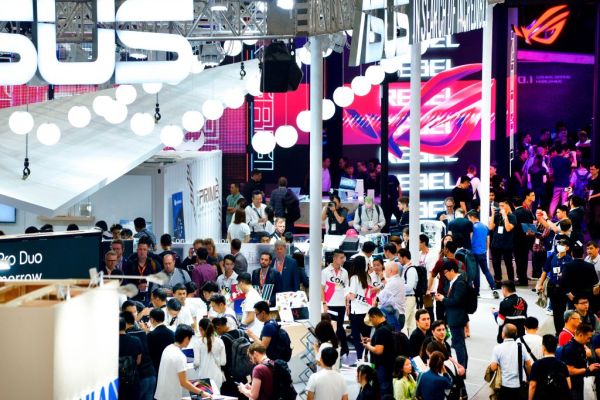After a relatively quiet show last year, Computex picked up the pace this year, with dueling chip launches by rivals AMD and Intel and a slew of laptop releases from Asus, Qualcomm, Nvidia, Lenovo and other companies.
Founded in 1981, the trade show, which took place last week from May 28 to June 1, is one of the ICT industry’s largest gatherings of OEMs and ODMs. In recent years, the show’s purview has widened, thanks to efforts by its organizers, the Taiwan External Trade Development Council and Taipei Computer Association, to attract two groups: high-end computer customers, such as hardcore gamers, and startups looking for investors and business partners. This makes for a larger, more diverse and livelier show. Computex’s organizers said this year’s event attracted 42,000 international visitors, a new record.
Though the worldwide PC market continues to see slow growth, demand for high-performance computers is still being driven by gamers and the popularity of esports and live-streaming sites like Twitch. Computex, with its large, elaborate booths run by brands like Asus’ Republic of Gaming, is a popular destination for many gamers (the show is open to the public, with tickets costing NTD $200, or about $6.40), and began hosting esport competitions a few years ago.
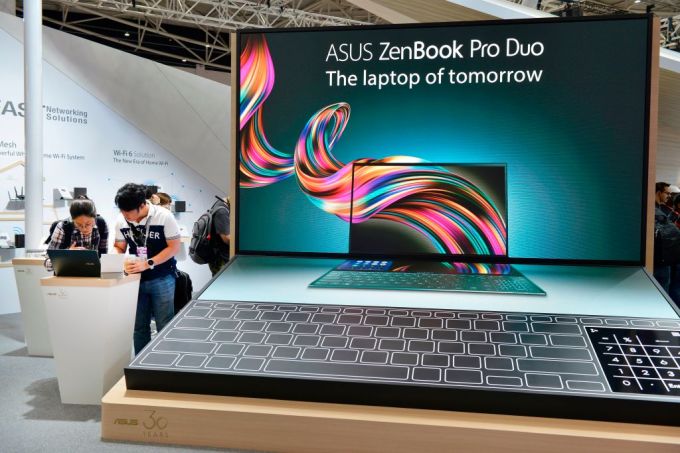
The timing of the show, formally known as the Taipei International Information Technology Show, at the end of May or beginning of June each year, also gives companies a chance to debut products they teased at CES or preview releases for other shows later in the year, including E3 and IFA.
One difference between Computex now and ten (or maybe even just five) years ago is that the increasing accessibility of high-end PCs means many customers keep a close eye on major announcements by companies like AMD, Intel and Nvidia, not only to see when more powerful processors will be available but also because of potential pricing wars. For example, many gamers hope competition from new graphic processor units from AMD will force Nvidia to bring down prices on its popular but expensive GPUs.
The Battle of the Chips
The biggest news at this year’s Computex was the intense rivalry between AMD and Intel, whose keynote presentations came after a very different twelve months for the two competitors.
Intel had a tumultuous year, coping with several leadership changes, including the resignation of CEO Brian Krzanich last June after revelations about a past relationship with an employee that broke management policy. He was replaced by Robert Swan, who previously served as Intel’s CFO, but the company still had to deal with setbacks including years of delays for its 10-nanometer processors, supply issues that made it hard to keep up with an unexpected rebound in the PC market and the revelation of the data-leaking bugs known as ZombieLoad. Meanwhile, AMD’s ability to deliver powerful desktop processors at competitive price points strengthened its reputation after years of being viewed as the underdog compared to Intel and Qualcomm.
This year’s Computex marked a milestone for AMD, the first time the company was invited to present Computex’s keynote. During the presentation last Monday, CEO Lisa Su not only officially launched long-anticipated chips and graphics processors, but revealed that several products, including all of its new 7-nanometer third-generation Ryzen CPUs, which AMD had previewed at CES in January, will go on sale next month on July 7.
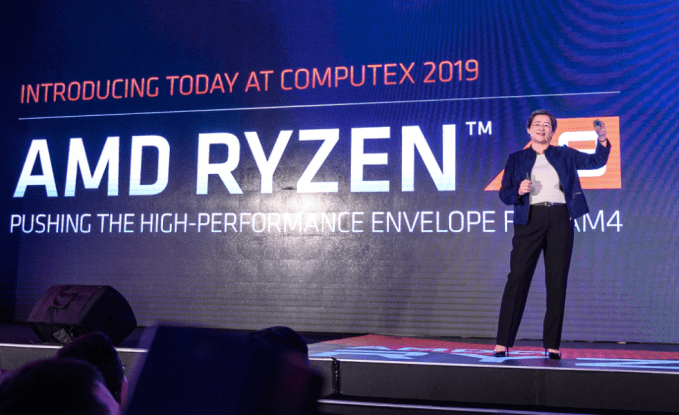
AMD CEO Lisa Su during her Computex keynote
The biggest surprise of the presentation, however, and AMD’s most explicit shot at Intel was its announcement that AMD’s 12-core, 24-thread Ryzen 9 3900x chip, the flagship of Ryzen’s third-generation series, will retail starting at $499, half the price of Intel’s competing Core i9 9920X chipset, which starts at $1,189.
In a Blender demo against the Intel i9 9920x, AMD claims the Ryzen 9 3900x finished about 18 percent more quickly. It also says that the 3900x is more efficient, with 4.6 Ghz boost speed and 70 MB of total cache running on 105 watts of thermal design power (versus the i9 9920x’s 165 watts).
While the Rzyen 9 3900x was the event’s showstopper, the low pricing for the entire third-generation Ryzen series (starting at $329 for the 8-core, 16-thread 3700X) made waves in the audience.
Heard folks saying “oh sh*t” and “holy sh*t” when AMD announced these prices #Computex pic.twitter.com/IteibnyBYM
— Bryan Ma (@bryanbma) May 27, 2019
Pricing details for AMD’s new Navi GPUs won’t be announced until E3 next month, a letdown for customers who had hoped for the start of a pricing war with Nvidia, but Su did reveal that the first Navi series, the Radeon RX 5000, will also be available next month.
After AMD’s impressive presentation (and Qualcomm’s announcement a few hours later that it would release a Snapdragon-powered 5G PC built in partnership with Lenovo), the pressure was on Intel to deliver in its own keynote the next day.
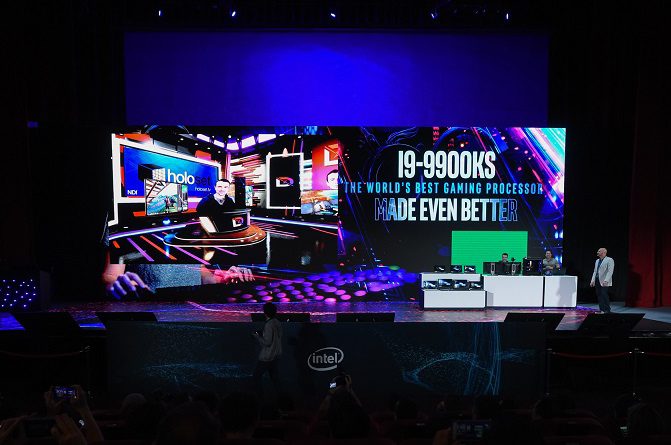
Gamer DrLupo joins Intel on stage to demonstrate the I9-9900KS
The company did not disappoint during a lavish presentation that included appearances by celebrities like Taiwanese singer Jam Hsiao and ice dancing siblings Alex and Maia Shibutani, both two-time Olympic bronze medalists. It recaptured some thunder from AMD’s Ryzen 9 3900x by revealing that its new Intel Core i9-9900KS processor, which it teased just before Computex, will be available by the holidays.
Part of Intel’s 9th-generation chip series, the i9-9900KS can run all eight of its cores at 5Ghz all the time and is targeted to power users like gamers who play and live stream at the same time.
Even though Intel hasn’t released a price yet, its impressive specs mean that many customers, including overclockers and hardcore gamers who build their own gear, who had been eyeing the Ryzen 9 3900x may instead wait a few more months to get more details about Intel’s chip before making a final decision.
Intel also released new details about its 10-nanometer Intel Core chips, code-named Ice Lake, which it had previewed at CES in January after years of delays. Based on Intel’s Sunny Cove architecture, the processors have integrated machine learning capabilities, support for WiFi 6, a new memory controller, larger caches and updated video and image processors. Ice Lake is now shipping to OEMs and devices powered by the processors are expected to be available to purchase in time for the holidays–another incentive for customers to wait until the end of the year to decide between Ice Lake and Ryzen.
The March of the Laptops
In addition to chips, many of the major keynotes focused on new laptops. Lenovo’s senior vice president of consumer devices Johnson Jia appeared at both Intel and Qualcomm’s presentations. At Intel, he showed off the 1.2kg Yoga S940 laptop, built on Intel’s new Project Athena specifications for laptops. The previous day at competitor Qualcomm’s keynote, he unveiled the first Snapdragon-powered laptop, called Project Limitless, that features an integrated 5G modem.
Project Limitless is a big deal for two reasons. First, the modem, Snapdragon X55 5G, was designed for use in smartphones. Secondly, Intel announced in April that it will not build 5G modems for smartphones, with Swan explaining that “in the smartphone modem business it has become apparent that there is no clear path to profitability and positive returns.” Qualcomm rubbed its new release in Intel’s face by placing large banners for Project Limitless throughout Taipei International Convention Center on the day of Intel’s keynote.
This is Savage ad placement, @Qualcomm. You have to see these banners as you walk up to the @Intel keynote at the #TICC at #Computex #Computex2019 pic.twitter.com/8lroSlqLnT
— Anshel Sag (@anshelsag) May 28, 2019
While many gamers were disappointed by Nvidia’s lack of major GPU announcements, the company did announce a new series of laptops positioned as a rival to the 15-inch MacBook Pro for creative professionals, video editors, graphics designers and photographers who demand increasingly fast rendering from their devices. Called Studio, the new laptop series will run Nvidia’s popular RTX graphics cards and begin retailing next month starting at $1,599.
Asus uses its Computex keynote to release new hardware and has developed a reputation for unveiling at least one quirky product each year. In 2016, it was the cute and reasonably affordable home robot Zenbo. Last year, it was a ZenBook Pro laptop with a 5.5-inch second screen in place of a touchpad.
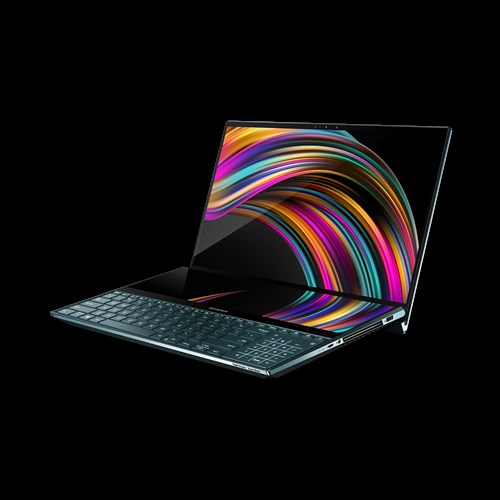
Asus’ new ZenBook Pro Duo
Though the idea seemed more like a novelty than an actual useful feature (imagine the all the finger and palm prints), Asus doubled down on the dual-screen laptop concept this year, knocking it out of the park with the ZenBook Pro Duo, which sports two 4K touchscreen displays. Instead of replacing the touchpad, the ZenBook Pro Duo’s 14-inch second screen extends all the way across the device above the keyboard, serving as both an extension and companion to the main 4K OLED 15.6-inch display.
The second screen is large enough to display multiple apps at once, making it useful for multitaskers. Asus hasn’t announced when the ZenBook Pro Duo will be available or how much it will cost, but it is one of the most interesting laptop form factor innovations in a long time, especially for people who thought the MacBook Pro’s Touch Bar was promising but wished it could be used for more than shortcuts, app controls or website and photo previews.
Where do startups fit in?
Most of the exhibitors at Computex are split into two venues: Nangang Exhibition Hall, where most of the major companies and many OEMs and ODMs have their booths and Taipei World Trade Center, which houses Innovex, Computex’s startup show. The two are very different in atmosphere. Nangang is filled with lavish booths (including several flashy two-story structures hosted gaming companies), “booth babes” (unlike many other trade shows, Computex has not banned scantily-clad models) and esport exhibitions.
This year, more than 467 startups from about 25 countries exhibited at Innovex, many attending as part of accelerator programs. There were also demos, forums and a pitch contest with a total prize pool of $340,000. For startups, Innovex is a chance to meet with potential supply chain partners, distributors and investors. According to Computex’s organizers, more than 45 international venture capital firms attended the show this year.
Edgar Chiu, managing partner at accelerator program SparkLabs Taipei, describes Innovex as “one of the largest events in Taiwan in terms of international investors.” While Computex is where companies go to find suppliers, Innovex is where they see “the new topics, the new trends that people are working on right now,” he says.
Though smaller and much less flashy than Nangang’s Computex floors, Innovex was noteworthy because of the large variety of startups, which offered products ranging from smart air diffusers and virtual reality headsets to supply chain management systems. During the show, visitors were asked to fill out a survey that asked them if they noticed more of an emphasis this year on IoT, AI and startups, giving a clue as to what Computex wants to be known for moving forward.
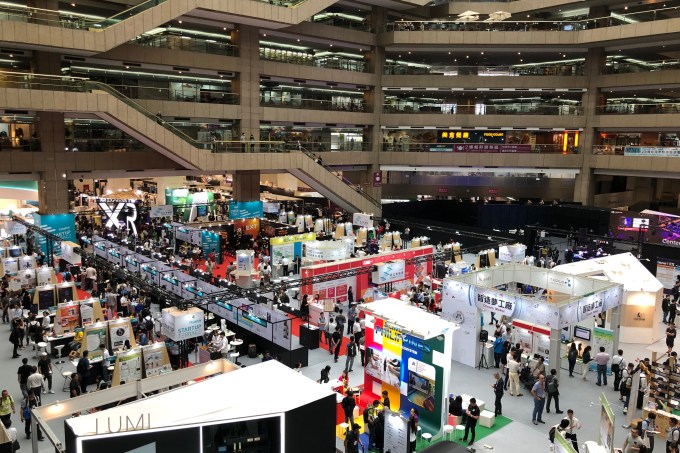
Several people who attended previous shows said that Innovex has evolved quickly over the last few years. Fox-Tech, a Taipei-based startup that makes IoT temperature and humidity sensors for agriculture, retail and manufacturing businesses, first demoed at Innovex in 2017 and then exhibited the next year at Computex in Nangang, but realized that it was “very B2C and we do B2B,” says co-founder and COO Yadia Colindres. This year, the company returned to Innovex as part of SparkLabs Taipei.
Colindres says she observed many more international visitors at the event this time, including other startups, potential business partners and investors. The people she talked to included representatives from a Thailand brewery who were interested in using Fox-Tech’s monitoring systems, a company from Dubai looking for similar IoT solutions and investors from Silicon Valley. With a more global focus this year, Innovex gave Colindres a chance to mingle with startups from countries Fox-Tech wants to enter, like France and the Netherlands, and get a sense of the tech scene there.
Despite the difference between their two venues, there is still plenty of synergy between Innovex and Computex. Many of the large companies that attend Computex to place production orders also check out Innovex in seek of opportunities for their corporate investment arms or new talent.
Chiu says that many companies travel to Innovex to look for software engineers or set up research and development centers in Taiwan (the country is becoming an important source of brainpower for overseas tech companies, including Google, which turned Taiwan into its largest Asian engineering hub after acquiring the bulk of HTC’s smartphone business last year. It recently doubled-down on the country, announcing plans to open a new office complex and hire several hundred new employees).
For companies from abroad, Innovex also serves as a gateway to Asian markets. Vivien Muller, CEO and founder of Luxembourg-based consumer hardware startup Mu Design, held a successful Kickstarter campaign for Ulo, its owl-shaped surveillance camera, but most of its backers were from Europe and the United States. During Innovex, he met with potential distributors from Japan, Taiwan and India, as well as investors. Having exhibited at CES earlier this year, Muller also appreciated Innovex’s more intimate size, which he said kept Ulo from being lost “in a sea of startups.”
